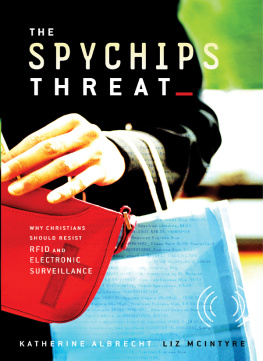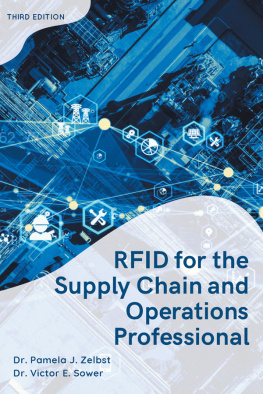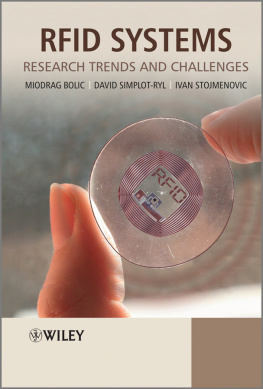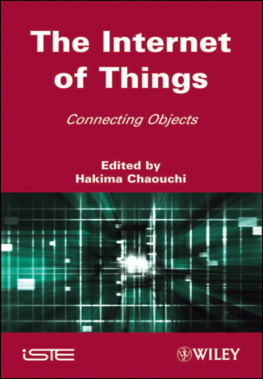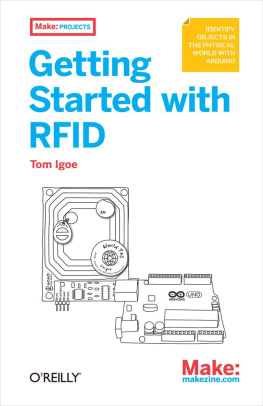Dobkin - The RF in RFID: UHF RFID in practice
Here you can read online Dobkin - The RF in RFID: UHF RFID in practice full text of the book (entire story) in english for free. Download pdf and epub, get meaning, cover and reviews about this ebook. year: 2013, publisher: Elsevier Science, genre: Romance novel. Description of the work, (preface) as well as reviews are available. Best literature library LitArk.com created for fans of good reading and offers a wide selection of genres:
Romance novel
Science fiction
Adventure
Detective
Science
History
Home and family
Prose
Art
Politics
Computer
Non-fiction
Religion
Business
Children
Humor
Choose a favorite category and find really read worthwhile books. Enjoy immersion in the world of imagination, feel the emotions of the characters or learn something new for yourself, make an fascinating discovery.

- Book:The RF in RFID: UHF RFID in practice
- Author:
- Publisher:Elsevier Science
- Genre:
- Year:2013
- Rating:4 / 5
- Favourites:Add to favourites
- Your mark:
- 80
- 1
- 2
- 3
- 4
- 5
The RF in RFID: UHF RFID in practice: summary, description and annotation
We offer to read an annotation, description, summary or preface (depends on what the author of the book "The RF in RFID: UHF RFID in practice" wrote himself). If you haven't found the necessary information about the book — write in the comments, we will try to find it.
Dobkin: author's other books
Who wrote The RF in RFID: UHF RFID in practice? Find out the surname, the name of the author of the book and a list of all author's works by series.
The RF in RFID: UHF RFID in practice — read online for free the complete book (whole text) full work
Below is the text of the book, divided by pages. System saving the place of the last page read, allows you to conveniently read the book "The RF in RFID: UHF RFID in practice" online for free, without having to search again every time where you left off. Put a bookmark, and you can go to the page where you finished reading at any time.
Font size:
Interval:
Bookmark:
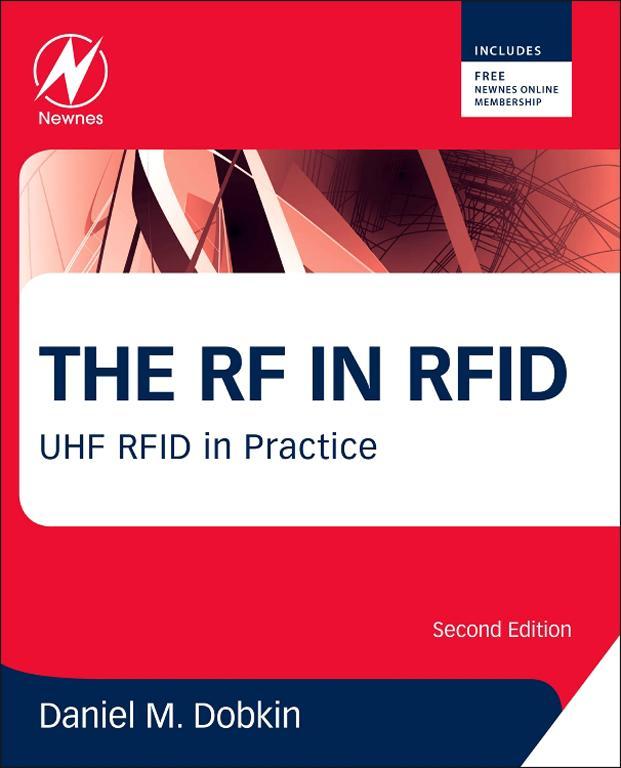
Daniel M. Dobkin

Newnes is an imprint of Elsevier
The Boulevard, Langford Lane, Kidlington, Oxford OX5 1GB, UK
225 Wyman Street, Waltham, MA 02451, USA
Second edition 2013
Copyright 2013 Elsevier Inc. All rights reserved
No part of this publication may be reproduced, stored in a retrieval system or transmitted in any form or by any means electronic, mechanical, photocopying, recording or otherwise without the prior written permission of the publisher
Permissions may be sought directly from Elseviers Science & Technology Rights Department in Oxford, UK: phone (+44) (0) 1865 843830; fax (+44) (0) 1865 853333; email: , and selecting obtaining permission to use Elsevier material
Notice
No responsibility is assumed by the publisher for any injury and/or damage to persons or property as a matter of products liability, negligence or otherwise, or from any use or operation of any methods, products, instructions or ideas contained in the material herein. Because of rapid advances in the medical sciences, in particular, independent verification of diagnoses and drug dosages should be made
British Library Cataloguing-in-Publication Data
A catalogue record for this book is available from the British Library
Library of Congress Cataloging-in-Publication Data
A catalog record for this book is available from the Library of Congress
ISBN: 978-0-12-394583-9
For information on all Newnes publications visit our web site at www.newnespress.com
Printed and bound in United States of America
13 14 15 16 17 10 9 8 7 6 5 4 3 2 1

To a quantum mechanic the whole universe is one godawful big interacting wavefunction but to the rest of us, its a world full of separate and distinguishable objects that hurt us when we kick them. At a few months of age, human children recognize objects, expect them to be permanent and move continuously, and display surprise when they arent or dont. We associate visual, tactile, and in some cases audible and olfactory sensations with identifiable physical things. Were hardwired to understand our environment as being composed of separable things with specific properties and locations. We understand the world in terms of what was where when. So one can forgive us for being disappointed that the computers and networks that form so large a part of our lives, and often seem so intelligent in other respects (at least on a good day), are clueless when it comes to perceiving and recognizing all these discrete physical objects we so easily detect and categorize. Why do we have to laboriously inform a computer database, by typing or mousing or tapping a screen, that a perfectly recognizable object has arrived at our doorstep? Why is so much human intervention needed for such a simple task?
It is to correct this deficiency of networked sensibilities that the field of automated identification (auto-ID) has arisen. Auto-ID includes any means of automating the task of identifying a physical object. To date, by far the most common means of doing so is to print a special machine-decipherable bar code on an object, and then image or scan the code using an optical transducer to extract an identifying number. One-dimensional bar codes (so named because information is obtained in traversing the pattern in a single direction, not because such patterns are in fact absent width and height) are easily deciphered and, in the form of the Universal Product Code (UPC) and its more modern descendents, nearly ubiquitous in the commercial world. Two-dimensional bar codes are also available, and pack more information into the same space. Optical character recognition (OCR) can be used to acquire information from conventional human-readable text, at the cost of an increase in computing requirements and decreased reliability. However, all optical methods of identifying an object have some deficiencies. Most fundamentally, the sensing device must be able to see the identifying mark: optical techniques require a clear line of sight. Not only objects, but dirt, paint, ink, and other objectionably opaque but relentlessly commonplace substances can distort or deface bar codes and other optical marks, obscuring the information optical auto-ID techniques require. Mechanical damage to the marks or labels degrades their readability. To store more data requires more space, or the use of finer markings visible from a shorter distance. Finally, data stored in printed marks on a surface is not readily modified or extended, save perhaps by wholesale replacement. While optical techniques for object identification are versatile and inexpensive, it is clear that in many cases another approach may be helpful.
To remedy some of the deficiencies of optical ID, we can turn to an alternative technique, radio-frequency identification (RFID). RFID is the use of radio communications to identify a physical object. RFID is really not one but a suite of identification technologies, because of the differing characteristics of the radio waves of varying frequency employed, and the differing approaches to operating the sensors that serve to identify individual objects. RFID has existed for more than half a century, but its widespread application has had to wait for inexpensive integrated circuits to enable small, low-cost transponders (the parts of the system that get attached to an object to be identified, more commonly known as RFID tags) to be fabricated. Over the last three decades, as the capability of integrated circuits has doubled and the cost per function halved about every two years, religiously attending to Gordon Moores famous law, new RFID applications have become economically feasible. In particular, since the mid-90s, a great deal of effort has been focused on the application of RFID in the manufacture and distribution of goods: supply chain management, where until recently the bar code reigned supreme. To serve the needs of manufacturing, distribution, and shipment functions, RFID tags must be very inexpensive, compact, mechanically robust, and readable from at least a meter or two away. As we will examine in more detail in , this combination of requirements has led to the choice of ultra-high-frequency (UHF) radio waves and passive RFID tags as the approach of choice for many supply chain applications, and it is UHF RFID technology that is the main topic of this book.
The purpose of The RF in RFID is to provide users of UHF RFID with an understanding of how identification information gets from a tag to a reader and in some cases back to the tag. We will use that understanding to see how the system of tags, readers, and antennas goes together, and analyze the capabilities and limitations resulting from the choices of tag, reader, antenna, and protocol. This book is for people who want to know why things RFID are the way they are and what (if anything) can be done about it, and perhaps be entertained upon occasion along the way.
Font size:
Interval:
Bookmark:
Similar books «The RF in RFID: UHF RFID in practice»
Look at similar books to The RF in RFID: UHF RFID in practice. We have selected literature similar in name and meaning in the hope of providing readers with more options to find new, interesting, not yet read works.
Discussion, reviews of the book The RF in RFID: UHF RFID in practice and just readers' own opinions. Leave your comments, write what you think about the work, its meaning or the main characters. Specify what exactly you liked and what you didn't like, and why you think so.

